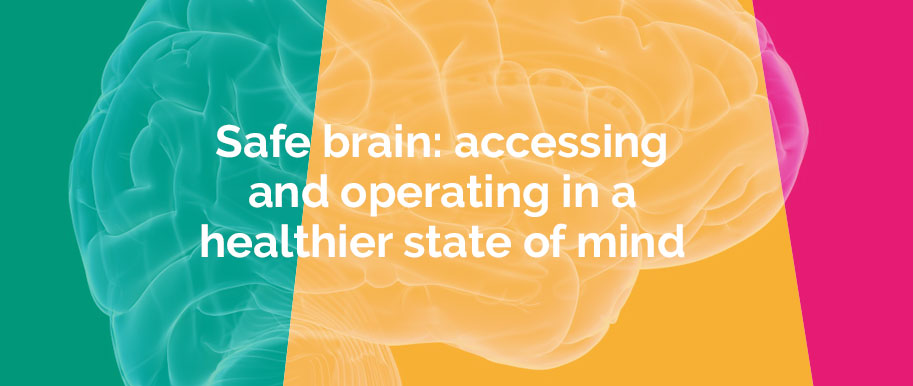Burnout, stress, endless conflict and pressure – just some of the challenges that leaders face on a daily basis.
In a business landscape that is increasingly characterised by complexity and volatility, organisations are operating in a highly-pressured and competitive environment. The result? Leaders have a limited range of knee-jerk responses: fight, flight or freeze. Using self-compassion to access ‘safe brain’ (Wickremasinghe, 2014) leaders can learn to broaden their range of behavioural choices. This enhanced range of behavioural options brings benefits such as better relationships, productivity, creativity and wellbeing. This harmonious state of affairs helps leaders to become more resilient and to create more resilient organisations.
Threat, safe and drive: one leader, three brains
Human behaviour is driven by three basic motivators: threat, safety and drive (Wickremasinghe, 2014). This neuroscientific approach helps us to understand the way that individuals act and it’s helpful to look at what they each mean.
Threat brain
‘Threat brain’ helps us to recognise threats and to immediately take action; this is the fight, flight or freeze response. As useful as ‘threat brain’ has been to our evolutionary development it cannot distinguish between real or imagined threats and struggles when faced with complexity. When a threat is perceived our body is flooded with noradrenaline and cortisol which boost energy ready for action. The brain and body quickly become fatigued from these chemicals and they can adversely impact health, reduce the ability to think openly and in a non-defensive way, inhibit the processing of new information and decrease memory.
Safe brain
Evolving from the need to nurture and protect the ‘safe brain’ is the opposite to ‘threat brain’, and is the soothing and contentment system. A rested and soothed self is able to make repairs in the body. Endorphins and oxytocin reduce blood pressure, stimulate the immune system, reduce anxiety and stimulate positive social interactions. According to research a mind in ‘safe brain’ can think more clearly and is able to process new information and develop insights with greater ease.
Drive brain
The desire to compete, achieve and accumulate things originates in our ‘drive brain’. The chemicals associated with ‘drive brain’ can be addictive, encouraging the individual to repeat those competitive and achievement-driven behaviours. Oft-regarded as desirable traits in business, competition and ambition are encouraged. However, this frequently is motivated by ‘threat’; while this may deliver results in the short term, without engaging ‘safe brain’ an unhealthy loop can be created in the long term that goes full circle back to stress, burnout and associated illnesses.
Why accessing ‘safe brain’ is beneficial
It’s clear that being in a state of ‘safe brain’ is preferable to operating under a ‘threat brain’ state. There are specific business benefits when leaders are in ‘safe brain’ mode:
- Productivity is increased – Chronic exposure to the chemicals released in the ‘threat brain’ state results in burnout. Absenteeism, or even presenteeism, prevails and the business suffers. By accessing ‘safe brain’, individuals can repair their bodies, stimulate their mind and re-engage with work.
- Creativity and innovation are enhanced – “Stress causes the part of the brain that is responsible for the human capacity to integrate new information, make complex decisions and creatively adapt, to shut down” (Brown, Kingsley and Paterson, p. 144). When in ‘safe brain’, clear thinking and new insights help to break down threat-drive behaviour patterns.
- Relationships become more effective – Oxytocin is released when ‘safe brain’ is accessed and this promotes attachment to and affiliation with others, leading to more positive social interactions. Attachment increases trust and when leaders trust their colleagues, relationships are more harmonious and effective.
All of these factors add up to create leaders that are healthier, feel happier and who are much more resilient. And resilient leaders mean resilient organisations too.
Accessing ‘safe brain’: how to
There’s no quick-fix kit that provides access to ‘safe brain’. It’s very much a living, working practice. The demands of corporate life increasingly mean that leaders must face complex problems that require more than linear problem-solving skills. Having access to a part of their mind that is receptive to new ideas, points of view and which is driven by inquiry instead of action provides a significant advantage.
How can they do it? It’s something we’ve worked on with many leaders. Here are a few tips on how leaders can access their ‘safe brain.’
- Self-compassion is the foundation. Empathy, non-judgement, care for wellbeing, sensitivity, sympathy, tolerance to distress are all compassionate characteristics (Wickremasinghe, 2014). Access to ‘safe brain’ is much more likely in leaders who have developed in these areas.
- Appreciation helps to access ‘safe brain’, as focusing on successes will help to produce oxytocin. This counteracts stress hormones and therefore reduces ‘threat brain’ behaviour.
- Self-exploration encourages leaders to become aware of their own behaviour, values, and experiences in order to discover and address issues – this helps to reduce ‘threat brain’ behaviour.
- Noticing how they are feeling the moment allows leaders to recognise ‘threat brain’ behaviours and to stop them before they take place. Mindfulness, meditation or deep breathing are examples of how leaders can pause for thought.
The key to safety
There’s no magic password that opens the door to the hallowed halls of ‘safe brain’. If there were, far fewer leader would be burnt out or suffering the ill effects of chronic stress. It takes continual practise and discipline to access ‘safe brain’; to get there, leaders must accept that there may be setbacks. When they can accept this of themselves it sets an example to the rest of the organisation, and curiosity, compassion, and creativity start to pave the way to commercial success. Isn’t that an organisation you’d like to lead?
